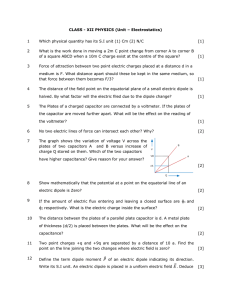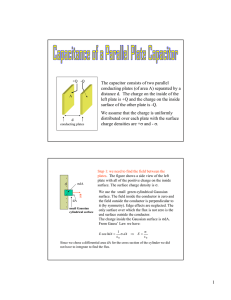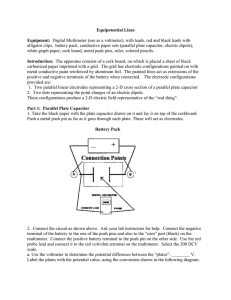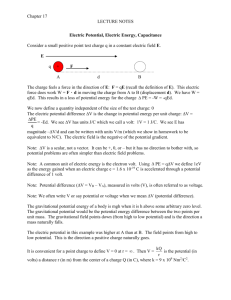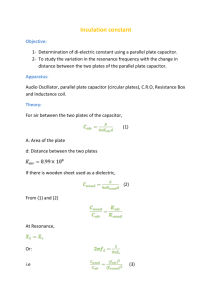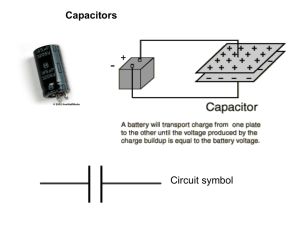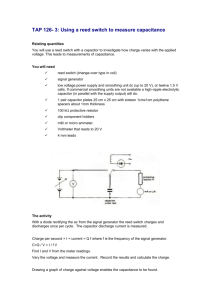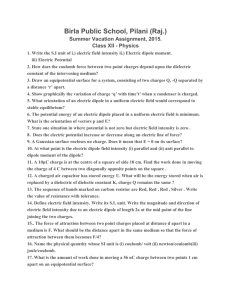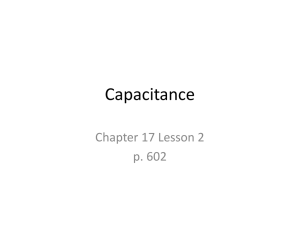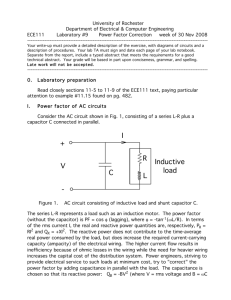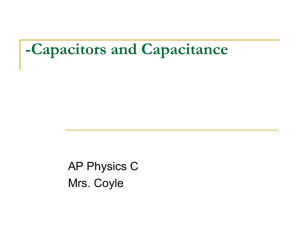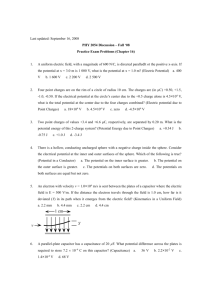hw03_solutions
advertisement
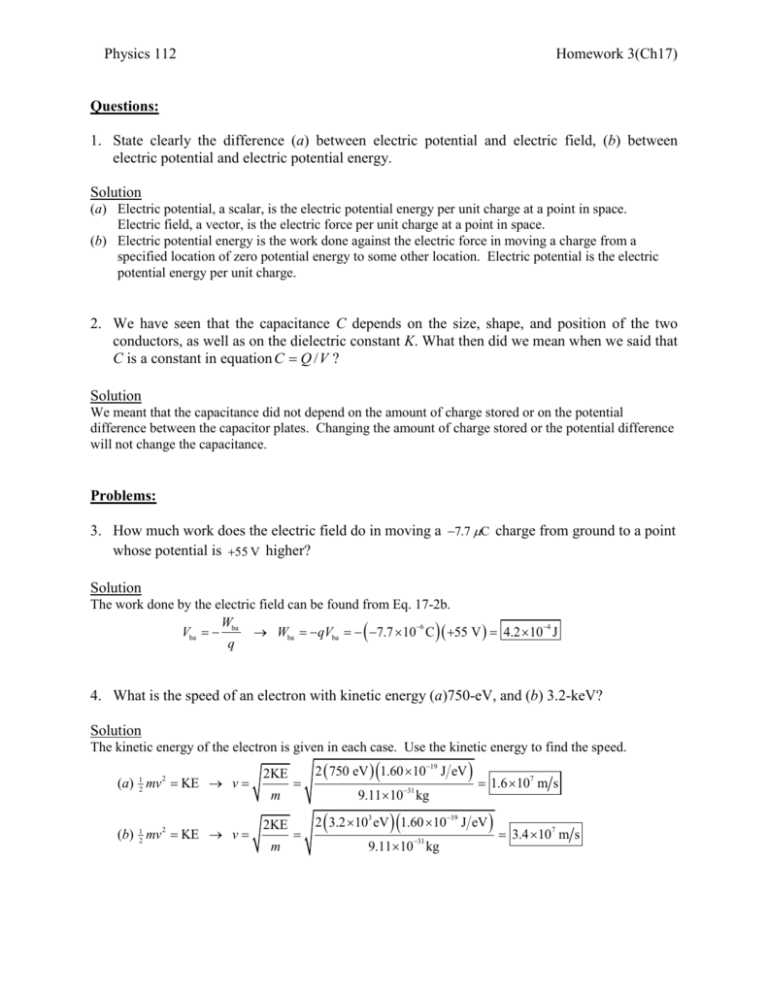
Physics 112 Homework 3(Ch17) Questions: 1. State clearly the difference (a) between electric potential and electric field, (b) between electric potential and electric potential energy. Solution (a) Electric potential, a scalar, is the electric potential energy per unit charge at a point in space. Electric field, a vector, is the electric force per unit charge at a point in space. (b) Electric potential energy is the work done against the electric force in moving a charge from a specified location of zero potential energy to some other location. Electric potential is the electric potential energy per unit charge. 2. We have seen that the capacitance C depends on the size, shape, and position of the two conductors, as well as on the dielectric constant K. What then did we mean when we said that C is a constant in equation C Q / V ? Solution We meant that the capacitance did not depend on the amount of charge stored or on the potential difference between the capacitor plates. Changing the amount of charge stored or the potential difference will not change the capacitance. Problems: 3. How much work does the electric field do in moving a 7.7 C charge from ground to a point whose potential is 55 V higher? Solution The work done by the electric field can be found from Eq. 17-2b. W Vba ba Wba qVba 7.7 106 C 55 V 4.2 104 J q 4. What is the speed of an electron with kinetic energy (a)750-eV, and (b) 3.2-keV? Solution The kinetic energy of the electron is given in each case. Use the kinetic energy to find the speed. (a) mv KE v 2KE (b) mv KE v 2KE 1 2 1 2 2 2 m m 2 750 eV 1.60 1019 J eV 31 9.1110 kg 1.6 10 2 3.2 103 eV 1.60 1019 J eV 31 9.11 10 kg 7 ms 3.4 10 7 ms Physics 112 Homework 3(Ch17) 5. Three point charges are arranged at the corners of a square of side L as shown in figure below. What is the potential at the fourth corner (point A), taking V 0 at a great distance? Solution The potential at the corner is the sum of the potentials due to each of the charges, using Eq. 17-5. V k 3Q L kQ 2L k 2Q L kQ 1 1 L 2 2kQ 2L 2 1 6. Calculate the electric potential due to a dipole whose dipole moment is 4.8 10 30 C m at a point 1.110 9 m away if this point is (a) along the axis of the dipole nearer the positive charge; (b) 45° above the axis but nearer the positive charge; (c) 45° above the axis but nearer the negative charge. Solution The potential due to the dipole is given by Eq. 17-6b. 8.99 109 N m 2 C 2 4.8 10 30 C m cos 0 kp cos (a) V 2 r2 1.1 109 m 3.6 102 V (b) V kp cos r 2 8.99 10 9 (c) V r 2 8.99 10 4.8 10 1.110 m 2 N m C 9 2 30 C m cos 45 Q 4.8 10 1.110 m 2 Q r o 2 N m 2 C2 9 r 9 2.5 102 V kp cos Q 30 Q C m cos135o r 2 2.5 10 V Q Q Physics 112 Homework 3(Ch17) 7. An electric field of 8.50 105 V m is desired between two parallel plates, each of area 35.0 cm2 and separated by 2.45 mm of air. What charge must be on each plate? Solution The desired electric field is the value of E V d for the capacitor. Q CV 0 AV d 0 AE 8.85 1012 C2 N m 2 35.0 10 4 m2 8.50 10 5 V m 2.63 108 C 8. The electric field between the plates of a paper-separated ( K 3.75) capacitor is 8.24 10 4 V m . The plates are 1.95 mm apart, and the charge on each plate is 0.775 C. Determine the capacitance of this capacitor and the area of each plate. Solution The capacitance is found from equation Q=CV, with the voltage given by equation V=Ed (ignoring the sign). Q 0.775 106 C Q CV C Ed C 4.82 109 F Ed 8.24 104 V m 1.95 103 m The plate area is found from equation: C K 0 A d A Cd K 0 4.82 10 F 1.95 10 m 0.283 m 3.75 8.85 10 C N m 9 3 12 2 2 2 9. How does the energy stored in a capacitor change if (a) the potential difference is doubled, and (b) the charge on each plate is doubled, as the capacitor remains connected to a battery? Solution (a) The energy stored in the capacitor is given by equation, PE 12 CV 2 . Assuming the capacitance is constant, then if the potential difference is doubled, the stored energy is multiplied by 4 . (b) Now we assume the potential difference is constant, since the capacitor remains connected to a battery. Then the energy stored in the capacitor is given by PE 12 QV , and so the stored energy is multiplied by 2 . Note, in this situation, the capacitance of the capacitor is not a constant (it is a capacitor with changeable geometry).

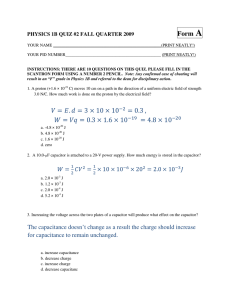

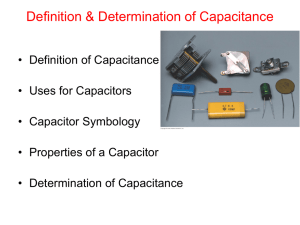

![Sample_hold[1]](http://s2.studylib.net/store/data/005360237_1-66a09447be9ffd6ace4f3f67c2fef5c7-300x300.png)
